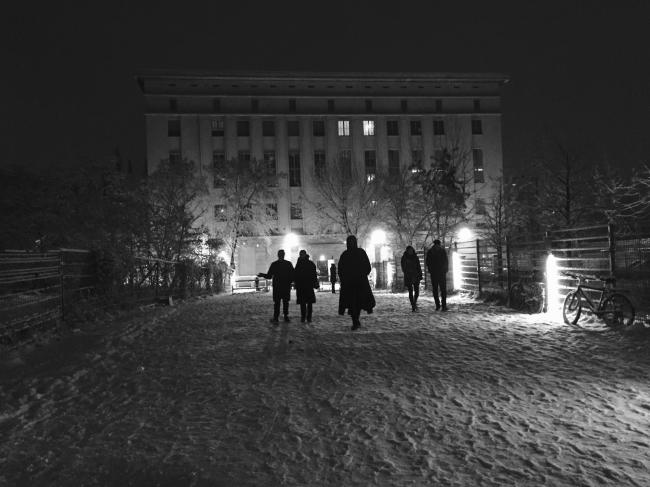Do you know the worldwide hippest club in Berlin at the moment? If you've ever been there, to Berghain, then you've probably also passed Sven Marquardt. The bouncer is not only an imposing figure because of his piercings and full-body tattoos, but is also known as a photographer of subcultural worlds. Born in 1962, Marquardt was part of the punk scene in the GDR and, as a photographer, also its chronicler. After reunification, he began his second career as a bouncer, but since 2003 he has been photographing again. From today until October 18, 2015, a personal exhibition of the enfant terrible can be seen in the Kunstraum gallery of the Waschhaus e.V. in Potsdam, always from Wednesday to Sunday from 1:00 pm to 6:00 pm. Admission is free and there are no controls at the entrance. The famous bouncer is only present framed and in colour. There is no reason to prevent anyone from visiting the exhibition. On the contrary! And even if the electronic bouncers are activated in a few days, anyone is welcome to browse illustrated books, regardless of your preferred dress code....
Sven Marquardt: Wild verschlossen (4° ZZF 27071)
The oldest pictures in this volume, published six months ago, are from 1984, the most recent from 2014. Unlike so many others, Marquardt did not photograph the dilapidated cityscape of East Berlin before the fall of the Berlin Wall. He was always interested in people, especially the self-promoters in their very own eccentricity and one more thing: "Love? Love? Love!!!", in its many variations. Initially, Sven Marquardt mainly portrayed his social environment. He has stuck with that. His current models are DJs, bouncers, artists and outsiders, whom he continues to photograph in elaborate settings. The volume brings together 100 portraits in stark black and white, bound in bright pink linen. Also a statement.
Sven Marquardt: Zukünftig vergangen (4° ZZF 21390)
Bernd Heimberger wrote about the photo book published in 2012: "Opening up to the photographer is the experience that makes Sven Marquardt's photographs an event. That was like that, that is like that. It was time to see that again, to rediscover the artist who tells his stories of encounters with people in his photographs. Everything that Marquardt wants to see – can see – is already in the pictures of the previous century. Everything is inherent in the beginning. Visible sexuality is always close to asexuality. Aliveness can never be seen without mortality. In every blameless pose, there is guilt, visible in the clear and indistinct, serious, sculptural faces."
Sven Marquardt: Nacht ist Leben (ZZF 25886)
Sven Marquadt would probably not put it quite like that. In fact, last year he told his life story to Erwin Strittmatter's granddaughter, Judka Strittmatter. The resulting autobiography sheds light on the backstory of the Cerberus of Berlin's nightlife culture. The resulting autobiography sheds light on the prehistory of the Cerberus of Berlin's nightlife culture. Marquard grew up in Pankow, skipped school early and became an alcoholic as a teenager. Helga Paris, the renowned photographer, became his lifeline and he still refers to her as his mentor today. He was apprenticed to DEFA in Babelsberg. After teh fall of the Berlin Wall, he initially sold shoes before the techno wave took hold of him. As a bouncer, he also became part of this scene; the first club he guarded was a converted shoe shop.
Robert Paris: Entschwundene Stadt. Berlin 1980 – 1989 (4° ZZF 27130)
In 1982, Sven Marquardt met the Paris family, photographer Helga Paris and her children Jenny and Robert. He quickly forms a close friendship with the son, who is the same age as he is. Together they roam through the gay subculture and the bars of Prenzlauer Berg. And they both take photographs.
Like Sven Marquardt, Robert Paris apprentice as a photographer and works as a lab technician for his mother. Two years ago, this volume was published, documenting his wanderings through the dilapidated streets of East Berlin, including the deserted Potsdamer Platz, crumbling façades in Fehrbelliner Straße, deserted railway stations, boarded-up doors and the old gasworks in Dimitroffstraße before, during and after its demolition. Unlike Sven Marquardt, Robert Paris is interested in the spent faces of places.
Helga Paris: Fotografie (4° ZZF 24576)
Helga Paris, born in 1938, actually studied fashion design; however, as her interest in photography grew, she began working as a photo lab technician before establishing herself as a freelance photographer at the end of the 1960s. She became an important mentor and artistic role model, not only for Sven Marquardt. "Her involvement with my pictures and her work as a photographer must have had a strong influence on me!?," Marquardt admits hesitantly. The volume documents her life's work.
Sibylle Bergemann: Photographien (4° ZZF 21391)
Another important role model for Sven Marquardt was the fashion photographer Sibylle Bergemann, who died four years ago and is considered one of the most important German photographers of the present day. "I consider her to be one of the most significant East German photographers," says Sven Marquardt. "I love her pictures. This melancholy... Which she never really wanted to acknowledge when asked about it!? I think she may have perceived melancholy as a kind of flaw!?" The exhibition volume presents her entire oeuvre, encompassing fashion, reportage, essay, landscape, cityscape and portrait.
Sibylle: Modefotografie aus drei Jahrzehnten DDR (ZZF 9004)
Since 1973, Sibylle Bergemann has had a major influence on the GDR fashion magazine that bore her first name but had already been founded in 1956. Through her mediation, Sven Marquardt also briefly worked for "Sibylle". However, due to his extroverted appearance, he had to secretly take a taxi to the editorial office outside office hours. This volume introduces the photographers of the magazine, which called itself "Magazine for Fashion and Culture" in its subtitle, with pictures and a short interview about their memories of their time at "Sibylle". The 13 pictures by Sven Marquardt were mostly "self-commissioned" and mainly show the extravagant clothing models of the designer collective Allerleirauh.
Geschlossene Gesellschaft (4° ZZF 24071)
This volume, which claims to be the first comprehensive publication on artistic photography in the GDR, presents 33 other artists in addition to Sven Marquardt. The selected positions convey the most important developments in photography in the GDR: montage and experiment, documentary and social reportage as well as the young photography of the 1980s. Press, fashion and advertising photography were deliberately excluded by the curators in order to separate supposed propaganda from art. The cross-section shows the very heterogeneous artistic positions of photographers in the GDR and invites to rediscover the forgotten, the overlooked or the well-remembered.
Matthias Leupold: Die Vergangenheit hat erst begonnen. Szenische Photographien 1983 – 1999 (4° ZZF 23567)
Among the photographers presented in "Geschlossene Gesellschaft" is Matthias Leupold. The cover of the illustrated book shows an action from 1983. Leupold was attending a screening of a Russian 3D film with some friends – all the spectators are wearing glasses and staring at the screen in unison – when Leupold has an acquaintance stand up in the middle of the film and remove his 3D glasses. With a gesture of shouting he holds his hands to his mouth; in another picture he holds a pistol to his temple. Leupold was able to take four shots before the group of friends were thrown out of the cinema. The photo series "In the cinema" series achieved cult status and became a symbol of the state independent art scene. Leupold, born in 1959, has worked as a freelance photographer in the GDR since 1985. In 1986, he applied for an exit visa. He has been a professor of artistic photography and digital visual media at the Berlin University of Applied Arts since 2007.
Too much future – Punk in der DDR (ZZF 21033)
Even if Sven Marquardt is not mentioned, the volume offers a complex overview of the many-faceted punk scene in the GDR and thus of the background to Marquardt's work. The authors include the writer and pub owner Bert Papenfuß, the painter Cornelia Schleime and the ZZF employee Bodo Mrozek. The texts address the beginnings of the punk movement, the strange constellation of punk and church in the GDR, the history of repression through persecution by the State Security and the interaction between punk and the (other) art underground.
(18.09.2015)

